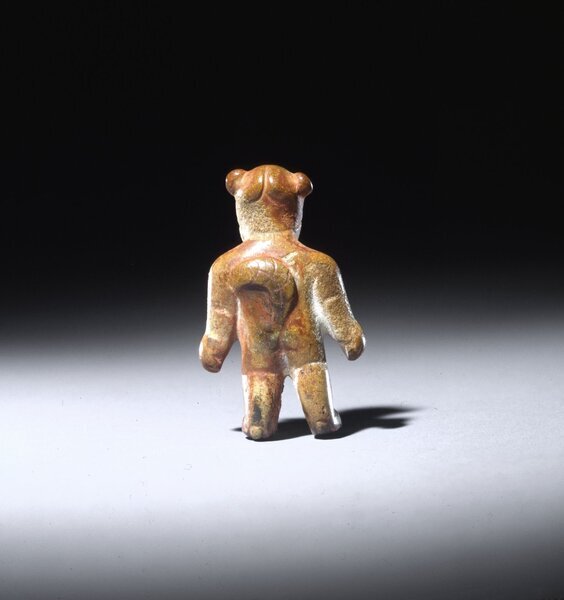Standing Figurine Item Number: L75.15 from the Brooklyn Museum


Description
Small figurine carved out of reddish-brown felsite with the typical Olmec drooping-lipped face. The figure also has features of an animal such as a cap with feline ears and a long, bushy tail at the back, both suggesting that he is wearing a costume of an animal, perhaps a jaguar. The figure has two small drill holes at the eyes and at the downturned corners of the mouth.
Credit Line
Collection of Christopher B. Martin
Label
The Olmec civilization (1400–400 B.C.E.) of Mexico’s Gulf Coast region produced small, portable figurines intended for ritualistic purposes. These three works display the characteristic Olmec sculptural features of a drooping lip and an elongated, flattened head. The winged figure and felsite figurine reflect the Olmec tradition of merging human and animal traits. Such composite forms relate to the ability of shamans, or ritual specialists, to transform themselves into animals. The wings represent those of a bat, associated with the darkness of the underworld. The figurine’s bushy tail and cap with feline ears suggest a jaguar, a sacred animal revered for its power. Jadeite and felsite were not native to Olmec ceremonial centers. Challenging to acquire and laborious to carve, they were valuable materials. The winged figure’s discovery in Costa Rica indicates the reverence for Olmec carvin
Item History
- Made between 801 BCE and 501 BCE
What
- Name
- Standing Figurine
- Identification Number
- L75.15
- Type of Item
- standing and figurine
- Material
- felsite and traces of red pigment
- Overall
- length 2.25 in, width 1.375 in, height 0.75 in
Who
- Culture
- Olmec
Where
- Holding Institution
- Brooklyn Museum
When
- Creation Date
- between 801 BCE and 501 BCE
Other
- Location
- American Identities: A New Look, American Art Galleries, 5th Floor, The Americas’ First Peoples, 4000 B.C.E.–1521 C.E., 5th Floor
- Classification
- Sculpture